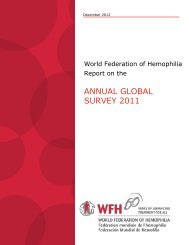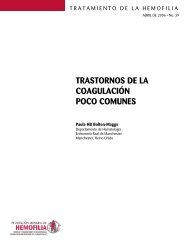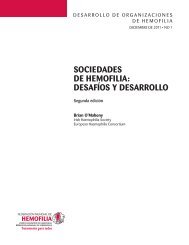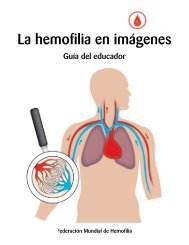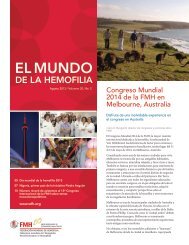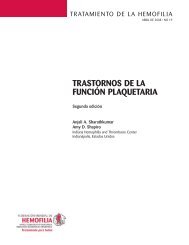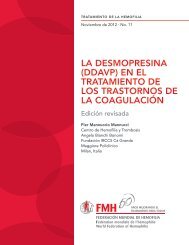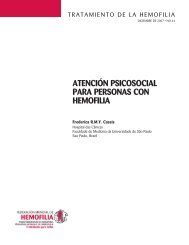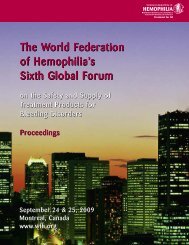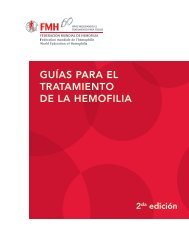Guide for the Assessment of Clotting Factor Concentrates
Guide for the Assessment of Clotting Factor Concentrates
Guide for the Assessment of Clotting Factor Concentrates
You also want an ePaper? Increase the reach of your titles
YUMPU automatically turns print PDFs into web optimized ePapers that Google loves.
APPENDIX 3GLOSSARYBatch release testing: Testing <strong>of</strong> end products by regulatory authorities be<strong>for</strong>e <strong>of</strong>ficial release toensure that <strong>the</strong> product specification is met.Characterization: Analytical measurements which allow detailed understanding <strong>of</strong> <strong>the</strong> compositionand o<strong>the</strong>r attributes <strong>of</strong> a product.Donor screening: Individual donations <strong>of</strong> blood are screened to ensure that blood-borne viruses donot enter <strong>the</strong> plasma pool. Screening is currently available <strong>for</strong> HBV, HCV, and HIV.Donor selection: Procedures designed to identify and exclude donors at risk <strong>of</strong> being infected withviruses that can be transmitted by blood transfusion.Enveloped/lipid enveloped viruses: The common transfusion transmitted viruses HIV, HCV, andHBV, which are all characterized by a lipid viral envelope and are highly infectious.Finished product testing: Testing done on final product to allow manufacturers to characterize <strong>the</strong>irproducts and to demonstrate compliance <strong>of</strong> every batch with <strong>the</strong> licensed specification.Fractionation: The process <strong>of</strong> separating and processing human blood plasma into a range <strong>of</strong> products<strong>for</strong> <strong>the</strong>rapeutic use.Good manufacturing practices (GMPs): All <strong>the</strong> elements in established practice that will collectivelylead to final products that consistently meet expected requirements as reflected in product specification.These include traceability, segregation <strong>of</strong> product manufacturing steps to avoid cross-contamination,training, documentation, change control, and deviation reporting.Inventory hold: The retention in storage <strong>of</strong> plasma <strong>for</strong> fractionation while processes designed toassure donor safety are undertaken.Limit testing: Testing <strong>of</strong> <strong>the</strong> plasma pool using nucleic acid testing (NAT) in which a maximum level<strong>of</strong> viral contamination, ra<strong>the</strong>r than an absolute elimination, is <strong>the</strong> aim.Lyophilization: The process <strong>of</strong> isolating a solid substance from solution by freezing <strong>the</strong> solution andevaporating <strong>the</strong> ice under vacuum. Freeze-drying.Marketing authorization: The <strong>for</strong>mal permit from a regulatory authority allowing a manufacturer tomarket a product following that authority's scrutiny.Minipools: Plasma samples pooled from several donations, and <strong>the</strong>n tested <strong>for</strong> viral markers.Nan<strong>of</strong>iltration: A process whereby protein solutions are passed over small pore filters which canremove viruses while allowing <strong>the</strong>rapeutic proteins to pass through.Non-enveloped /non-lipid enveloped viruses: Pathogenic viruses (<strong>for</strong> example, HAV or parvovirusB19) which lack a lipid envelope and <strong>the</strong>re<strong>for</strong>e are not susceptible to viral inactivation techniques suchas solvent-detergent treatment.<strong>Guide</strong> <strong>for</strong> <strong>the</strong> <strong>Assessment</strong> <strong>of</strong> <strong>Clotting</strong> <strong>Factor</strong> <strong>Concentrates</strong> 47



